My journey back to Potato Point – an otherwise crazy-looking route into the central west of NSW – is determined by a desire to visit Sculptures in the Scrub near Baradine. As it happens, that doesn’t happen. It rains and I’m advised not to take the Yaris along the 30 kilometres of dirt. An extraordinarily helpful woman at the Pilliga Discovery Centre tells me about an alternative, and assures me I won’t be disappointed. It means a detour of 70 kilometres, but who’s counting kilometres on this particular adventure?
So I head up the Newell Highway, something I usually avoid like poison, and take a turnoff along a sandy track. The local Aboriginal community doesn’t advertise these special caves by a highway sign, but I have a brochure with directions.
I walk along well-marked and easy path, through burnt out bush where wildflowers are beginning to flower and young leaves are backed by black stumps.
The path slopes gently upwards until I have a view across the Pilliga Scrub. And then the rocks appear. For about a kilometre I’m walking around a massive outcrop of sandstone, lost for words in the face of the beauty of pattern and variety, as I was in the immensity of Wadi Rum, and at Wasp Head near home.
There are signs of the Ancestors, caged behind steel bars to protect them from vandals, who have already damaged a grinding rock by trying to mimic the action, and carted away a piece of rock with peckings. The horizontal gap in the cage is a doorway for bats.
The white rock shows grinding grooves where Gamilaraay people shaped and sharpened stone axes and other tools against the sandstone.
The second cage encloses pecked etchings of emu and kangaroo footprints that may be 12 000 years old, and more grinding grooves.
I sit for a moment on a convenient bench and look out over the Pilliga, as the Ancestors must have done for thousands of years without the intrusion of farmland …
… and then return to intent perusal of unremitting beauty.







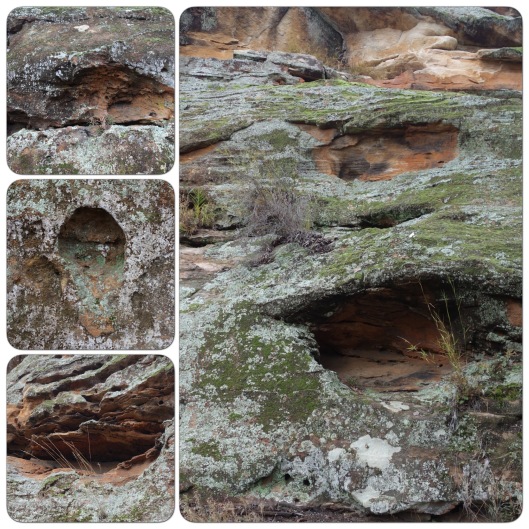

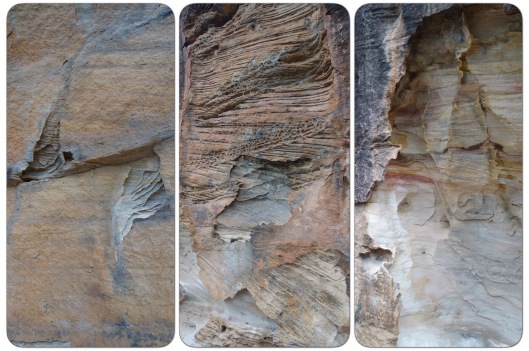


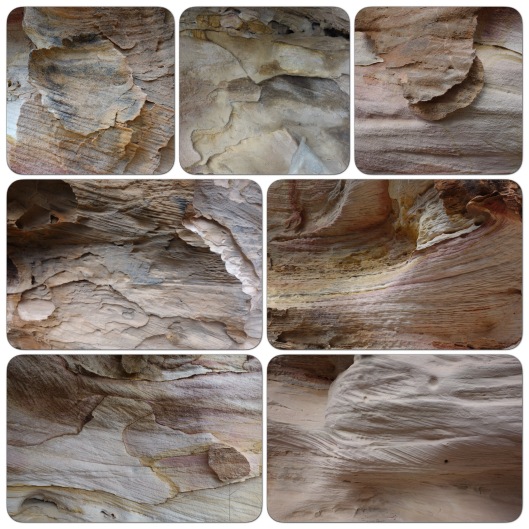




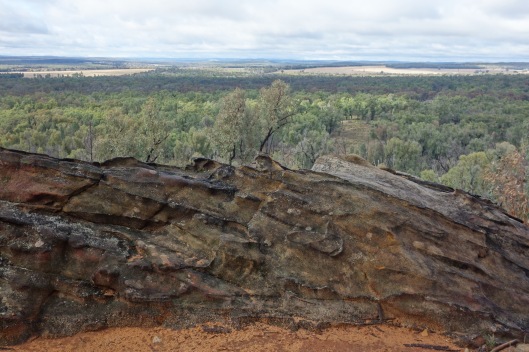

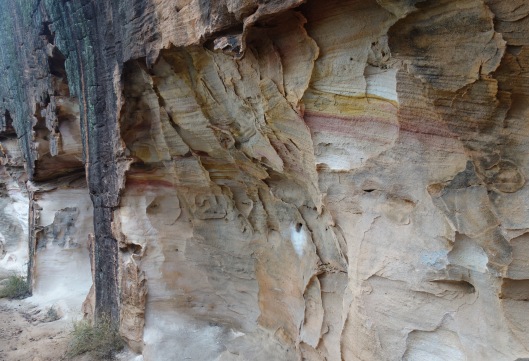






I love the colours and patterns in these rocks. Reminiscent of Namibia and the San Bushmen paintings and also the Canyons in Arizona/Utah with the rich rocky landscapes that took my breath away: both without the heavy footprints of man.
LikeLike
I love being around your well-travelledness and the connections you make. Take your breath away experiences are so precious.
LikeLiked by 1 person
And so rare these days…
LikeLike
You must have been chuffed to bits to find this place, it’s really, really stunning!
LikeLike
It was one of those gasp … gasp … gasp walks. It had both present beauty and a sense of long human history. I’ve just reserved a book about the Pilliga called “A million wild acres”: I’ve been meaning to read it for years and now’s obviously the time.
LikeLike
What a fascinating place. It’s easy to imagine aboriginal people sitting on the rock shelf of the last two photos. Their spirit comes through even in the photos. Thanks for taking us on such an interesting journey.
LikeLike
I felt it as a gift: a disappointment becomes a gift. The fossils at Wellington caves were another such gift when the cave tour fell through. And having seen these caves, I rather didn’t want to overlay other very different caves.
LikeLike
I really enjoyed your photos of the caves. I’m very glad I don’t have to live in one though. 🙂
LikeLike
More overhangs than caves – but I still favour houses!
LikeLiked by 1 person
Me too – just got caught in the rain 😦 It was very good to get home.
LikeLike
Judy and I enjoyed both of these walks and views on our recent jaunt to Pilliga Pottery and Moree hot springs. x
LikeLike
How did you find the road into the sculptures? ie it’s quality, not its whereabouts! I’m jealous. I really want to go back in full spring – it looks as if it would be flower heaven.
LikeLike
The road was very corrugated, similar to the Grawin Rd in the old days. You were wise not to do it in your car in wet weather. I really enjoyed having another look at the rocks through your lens, and by the way I can see everything very clearly in your posts. We also went to the Sawn Rocks in Mt Kaputar National Park and noted we have more to do in that area also. Full spring sounds like a good time for all these walks. x
LikeLike
You must have been in rock heaven, Meg! Worth the 70km detour!
LikeLike
Would’ve been worth 1000 km, I think.
LikeLiked by 1 person
Excellent!!
LikeLike
I need bigger shots! I know you like your gallery format but I miss out on so much in these tiny squares. The details could be ravishing. 🙂 🙂
LikeLike
Do you really want a blog with 150 photos? That’s what it would have been, and it’s how I wanted to do it too, I only like my gallery format because it cheats on my no more than 15 photos rule. Maybe I’ll pick fifteen and do another post of full shots.
LikeLike
I’ll go for the second option. 🙂 🙂 I would prefer bigger and fewer… just occasionally 🙂
LikeLiked by 1 person
I have to agree with Jo on this occasion, Meg!
LikeLike
You see! It’s not just me who needs spectacles for your posts. 🙂 🙂 But don’t go humouring me. You’re in charge.
LikeLiked by 1 person
I think my astigmatism is getting worse…perhaps a visit to the opticians will sort me out for a while, and I’ll be able to do Meg-galleries again!! 😀
LikeLiked by 1 person
Please don’t drive me to blog from the laptop. I’ve hardly used it for two years and I’ll have to relearn it. Photo editing on iPad doesn’t transfer so … Ohhh noooo!!!
LikeLiked by 1 person
Oh, OK, I take that as a ‘no’ then!
LikeLike
Have you tapped on collage to make it fill the screen? You’ve worried me!
LikeLike
Sorry Meg. I’m in the bath. Not sure if it’s me or Sue causing concern. I’m fine. I’ll have another look tomorrow xx
LikeLike
Concern because I’m not servicing my readers adequately!
LikeLike
Rubbish! Of course you are! You have an individual style that’s selected by you and suits you and if we don’t like it…. we won’t come back. But you KNOW we will 🙂 🙂
LikeLike
Back this morning with my eyes and my brain. 🙂 2748 is my favourite- all swirly, whirly! It’s fine for the 2/3 shots but the composites are no bigger. Still love you! 🙂
LikeLike
The composites are … individual works of art??? I don’t know what’s going on. They all look as fine on my tablet as they are. Name me a particular one and I’ll see if I can figure something out. Hugs from a woman with a functioning battery – I hope.
LikeLike
Nope! You just stay happy as is, and thank heavens for working batteries. I wish my brain did. 🙂 🙂
LikeLike
Remains to be seen – about the car battery, I mean: I’ve no doubt about the functioning of your brain. I’m risking it on 100km trip today.
LikeLiked by 1 person
Er… sensible? Hopefully some good garages en route? Proceed with caution 🙂 🙂
LikeLike
Garages in one town halfway, but J on tap and the NRMA, as long as I remember my phone!!! I’m going to see a friend – last chance before she heads off to England for three months. So I’ll risk it.
LikeLike
Travel safe, and smoothly. 🙂 🙂
LikeLike
Are you viewing the collages on a laptop or a phone? They enlarge fine for me on the laptop.
LikeLiked by 1 person
I agree with Jo. I have been a little disappointed by the fuzziness when I enlarge individual photos within the collages, and not just in this post. I wondered whether that might have been because of the camera used on that occasion. On other occasions the enlarged images have been crystal clear.
LikeLiked by 1 person
PS The boronia is lovely. For those not familiar with Australian flora, that is the pink flower with four petals.
LikeLike
OK. It would be useful to identify particular blurs you notice. You might be right about camera, but I’ve checked and I don’t see blur, at least in any of the rocks. Flowers maybe. Next time you notice it let me know.
LikeLike
You can click on to the collages (on a laptop/PC anyway) and then enlarge even further to see the colours, textures and patterns better. Works for me!
LikeLike
I forget to use the magnifying thing. You know I have a touch of the scarecrows. (if I only had a brain… 🙂 )
LikeLiked by 1 person
You’ve got to stop saying things like this: they seem to be proliferating, and I don’t like my friends to be self-defamatory. And maybe the poster shouldn’t expect the reader to do all the work!
LikeLike
Be gentle with me tonight, Meg. My friend lost her battle today. I’ll try not to do this in future. 🙂
LikeLike
I just realised that. I’ve emailed you. One should never be other than gentle.
LikeLike
I know. Thank you. I have it. Returning the hugs xx
LikeLike